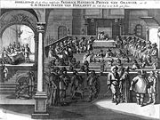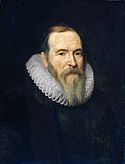
States of Holland
Encyclopedia
.jpg)
Estates of the realm
The Estates of the realm were the broad social orders of the hierarchically conceived society, recognized in the Middle Ages and Early Modern period in Christian Europe; they are sometimes distinguished as the three estates: the clergy, the nobility, and commoners, and are often referred to by...
(standen) (Nobility and Commons) to the court of the Count of Holland
Count of Holland
The Counts of Holland ruled over the County of Holland in the Low Countries between the 10th and the 16th century.-House of Holland:The first count of Holland, Dirk I, was the son or foster-son of Gerolf, Count in Frisia...
. After the United Provinces
Dutch Republic
The Dutch Republic — officially known as the Republic of the Seven United Netherlands , the Republic of the United Netherlands, or the Republic of the Seven United Provinces — was a republic in Europe existing from 1581 to 1795, preceding the Batavian Republic and ultimately...
were formed — and there no longer was a count, but only his "lieutenant" (the stadtholder
Stadtholder
A Stadtholder A Stadtholder A Stadtholder (Dutch: stadhouder [], "steward" or "lieutenant", literally place holder, holding someones place, possibly a calque of German Statthalter, French lieutenant, or Middle Latin locum tenens...
) - they continued to function as the government of the County of Holland
County of Holland
The County of Holland was a county in the Holy Roman Empire and from 1482 part of the Habsburg Netherlands in what is now the Netherlands. It covered an area roughly corresponding to the current Dutch provinces of North-Holland and South-Holland, as well as the islands of Terschelling, Vlieland,...
.


Land's Advocate of Holland
The Land's Advocate of Holland acted as the chairman of the States of Holland. The office started in the early 14th century and ended in 1619, when the title was renamed into Grand Pensionary. He was the speaker of the nobility of Holland and had the first say on a subject during a meeting of the...
or Grand Pensionary
Grand Pensionary
The Grand Pensionary was the most important Dutch official during the time of the United Provinces. In theory he was only a civil servant of the Estates of the dominant province among the Seven United Provinces: the county of Holland...
of Holland, who combined the votes of the ten members of the Ridderschap (the "Knighthood") in the estates; the nobility was also supposed to represent all rural interest, including those of the farmers. The Commons consisted of representatives of eighteen cities, in ancient feudal order: eleven of the Southern Quarter: Dordrecht
Dordrecht
Dordrecht , colloquially Dordt, historically in English named Dort, is a city and municipality in the western Netherlands, located in the province of South Holland. It is the fourth largest city of the province, having a population of 118,601 in 2009...
, Haarlem
Haarlem
Haarlem is a municipality and a city in the Netherlands. It is the capital of the province of North Holland, the northern half of Holland, which at one time was the most powerful of the seven provinces of the Dutch Republic...
, Delft
Delft
Delft is a city and municipality in the province of South Holland , the Netherlands. It is located between Rotterdam and The Hague....
, Leyden, Amsterdam
Amsterdam
Amsterdam is the largest city and the capital of the Netherlands. The current position of Amsterdam as capital city of the Kingdom of the Netherlands is governed by the constitution of August 24, 1815 and its successors. Amsterdam has a population of 783,364 within city limits, an urban population...
, Gouda
Gouda
Gouda is a city and municipality in the western Netherlands, in the province of South Holland. Gouda, which was granted city rights in 1272, is famous for its Gouda cheese, smoking pipes, and 15th-century city hall....
, Rotterdam
Rotterdam
Rotterdam is the second-largest city in the Netherlands and one of the largest ports in the world. Starting as a dam on the Rotte river, Rotterdam has grown into a major international commercial centre...
, Gorinchem
Gorinchem
Gorinchem , also called Gorkum , is a city and municipality in the western Netherlands, in the province of South Holland. The municipality covers an area of 21.99 km² of which 3.03 km² is water...
, Schiedam
Schiedam
Schiedam is a city and municipality in the province of South Holland in the Netherlands. It is part of the Rotterdam metropolitan area. The city is located west of Rotterdam, east of Vlaardingen and south of Delft...
, Schoonhoven
Schoonhoven
Schoonhoven is a city and municipality in the western Netherlands, in the province of South Holland. The municipality has a population of 12,195 , and covers an area of 6.96 km²...
and Brill; seven of the Northern Quarter: Alkmaar
Alkmaar
Alkmaar is a municipality and a city in the Netherlands, in the province of Noord Holland. Alkmaar is well known for its traditional cheese market. For tourists, it is a popular cultural destination.-History:...
, Hoorn
Hoorn
-Cities :* Purmerend * Enkhuizen * Alkmaar * Amsterdam * Lelystad * Den Helder * Leeuwarden -Towns :* Edam...
, Enkhuizen
Enkhuizen
Enkhuizen is a municipality and a town in the Netherlands, in the province of North Holland and the region of West-Frisia.Enkhuizen was one of the harbour-towns of the VOC, just like Hoorn and Amsterdam, from where overseas trade with the East Indies was conducted. It received city rights in 1355...
, Edam, Monnikendam, Medemblik
Medemblik
Medemblik is a municipality and a town in the Netherlands, in the province of North Holland and the region of West-Frisia.- History :...
and Purmerend
Purmerend
Purmerend is a municipality and a city in the Netherlands, in the province of North Holland.The city is surrounded by polders, such as the Purmer, Beemster and the Wormer. The city became the trade center of the region but the population grew relatively slow. Only after 1960 did the population...
.
More powerful cities were allowed to send more representatives — Amsterdam had a delegation of four — but these then together had only one vote. All members of the States were appointed officials, including the Land's Advocate or Grand Pensionary, who was appointed by the States themselves. The Land's Advocate or Grand Pensionary was nearly always a previous pensionary of a city. Very important matters, such as about taxation, had to be decided on unanimously but normally decisions were made by majority. This majority was not reached after a voting procedure, but by a summary at the end of the meeting by the Land's Advocate or the Grand Pensionary of the opinions expressed by the several members present, who would speak according to the feudal order: Dordrecht
Dordrecht
Dordrecht , colloquially Dordt, historically in English named Dort, is a city and municipality in the western Netherlands, located in the province of South Holland. It is the fourth largest city of the province, having a population of 118,601 in 2009...
first, Purmerend
Purmerend
Purmerend is a municipality and a city in the Netherlands, in the province of North Holland.The city is surrounded by polders, such as the Purmer, Beemster and the Wormer. The city became the trade center of the region but the population grew relatively slow. Only after 1960 did the population...
last. He had literally both the first — as representing the nobility vote — and the last say in a meeting. Since the death of Johan van Oldebarnevelt any Prince of Orange
Prince of Orange
Prince of Orange is a title of nobility, originally associated with the Principality of Orange, in what is now southern France. In French it is la Principauté d'Orange....
also being stadtholder indirectly had much power over the States. He had the right to appoint the mayors of all cities, out of one of two candidates suggested by the appointment college of a city. Mayors of cities with city rights chose the officials who served as representatives in the States of Holland. The States of Holland were disbanded during the reforms by the Batavian Republic
Batavian Republic
The Batavian Republic was the successor of the Republic of the United Netherlands. It was proclaimed on January 19, 1795, and ended on June 5, 1806, with the accession of Louis Bonaparte to the throne of the Kingdom of Holland....
.
The States
The States
The States or the Estates signifies the assembly of the representatives of the estates of the realm, called together for purposes of legislation or deliberation...
of Holland should not be confused with the States-General, or Staten-Generaal, the confederate government of the Republic of the Seven United Netherlands as a whole. Each of the Netherlands had its own States
The States
The States or the Estates signifies the assembly of the representatives of the estates of the realm, called together for purposes of legislation or deliberation...
and Holland was just one of seven. Nevertheless this province was so dominant that a politician controlling the States of Holland by being Land's Advocate of Holland or Grand Pensionary, in fact controlled the Republic. Johan de Witt
Johan de Witt
Johan de Witt, heer van Zuid- en Noord-Linschoten, Snelrewaard, Hekendorp and IJsselveere was a key figure in Dutch politics in the mid 17th century, when its flourishing sea trade in a period of globalization made the United Provinces a leading European power during the Dutch Golden Age...
is a case in point, and Johan van Oldebarnevelt another famous example.
First mentioned in 1428, the States of Holland continued to exist until 1795 when the Batavian Republic
Batavian Republic
The Batavian Republic was the successor of the Republic of the United Netherlands. It was proclaimed on January 19, 1795, and ended on June 5, 1806, with the accession of Louis Bonaparte to the throne of the Kingdom of Holland....
was established under French rule.

